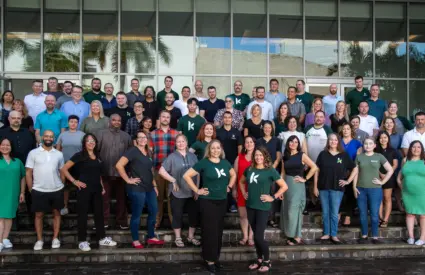Well, it’s official. We made it through the pandemic (or at least we’re getting close)! Dr. Rochelle Walensky, Director of the Centers for Disease Control and Prevention (CDC), recently stated that the world is “certainly a very different place” in 2023 than we were even a year ago, or ever before. While we are all undoubtedly grateful to have made it through such a challenging global event, it’s essential to acknowledge that the pandemic has taken a toll on all of us in one way or another, most notably concerning our mental health.
That’s why it’s become increasingly important to take a step back and assess the ongoing impact the last few years have had on our workplace and the mental health of ourselves and our colleagues. While we can’t hit a reset button, we can look at a few ways to continue supporting each other at work — because when we’re feeling good, we can do great work together!
At Kanopi, we consider ourselves an employee-first organization — which is less like being the host of the best party ever, with free snacks, free drinks, and a foosball table (we are fully remote, after all), and more like prioritizing the needs and well-being of our employees above all else. To take this best-party-ever metaphor a bit further, our employees are the proverbial guests of honor, and we work hard to show them that they are valued and appreciated. That may seem like a tall order. But we’ve run a fully-remote agency since 2010 with consistently high retention and employee satisfaction numbers.
So, what are some ways we take care of our employees, and suggest you do the same?
Prioritize work-life balance.
If you’ve ever worked in an agency, you know the idea of work-life balance can be tricky, if not impossible. We try our hardest to break that stigma by encouraging our employees to prioritize self-care, whether taking breaks throughout the day, participating in physical activity, or making time for family. We also do our very best to keep work at work; if a person is done for the day or the week, they’ll only hear from colleagues about work during “off-hours” if it’s an absolute emergency.
How you can prioritize work-life balance for your employees: Better Up, an organization focused on executive coaching to improve employer/employee relationships, wrote this blog post with 12 tips to understand the need for and improve work-life balance for yourself AND your employees.
We hold space to “not be okay.”
Because we are fully remote, much of our inner-office communication happens via Slack. We made a conscious effort to create special-interest channels within Slack for our employees, one of which is our #being-human channel. It is a safe and supportive space where employees are encouraged to vent and support the person venting, helping everyone practice vulnerability and feel heard and validated without judgment. When we hold space for someone, we say, “I see you, I hear you, and I’m here for you.” It’s a powerful way we build trust, strengthen relationships, and foster a culture of empathy and understanding.
How you can hold space for your employees: This article, written in 2020 by the Harvard Business Journal, outlines some ways that employers can hold space for employees who are “not okay.” Their advice still holds true in a post-pandemic world.
We support social connections.
Because our employees are spread out across the US and Canada, we provide a small “dinner and drinks” stipend to encourage employees who live close to each other to connect in person. This can help to combat feelings of isolation and loneliness that may have been exacerbated by the pandemic while fostering a sense of community and belonging.
How you can support social connections: If in-person meet-ups aren’t accessible for your organization, Flexjobs, a resource for employers (and job seekers) who have remote workforces, wrote this excellent article about ways remote workers can connect and spend time together that is not strictly work-focused. It includes a “question of the week,” fun company contests, and virtual workout breaks.
We provide mental health resources.
By ensuring our benefits align with employee mental health resources coverage, we are secure that our employees can manage their mental health concerns more effectively. That said, similar types of support are offered in other, less conventional forms — from our Employee Assistance Program (EAP), which provides access to mental health professionals and resources in the US, to an employee-run meditation practice, held three times a week on Zoom. These resources can help employees feel more supported and improve their mental well-being.
How you can incorporate mental health resources: This article from Mental Health America demonstrates low-cost, high-impact ways businesses can support and improve the mental health of their employees, including reviewing policies and making contingency plans.
Supporting mental health is right. And smart.
Supporting employee mental health isn’t just the right thing to do; it’s the smart thing to do. It’s like giving your employees the best gift bag at the party, except instead of cool trinkets, they have the power to be happier, healthier, and more productive. And let’s be honest, who wouldn’t want a team of happy, healthy, and productive employees?
Based upon our quarterly employee happiness survey, our commitment to being an employee-first organization is one of the key factors behind our excellent retention rates, year over year. So, whether you are providing mental health resources, promoting work-life balance, or simply holding space for your employees, investing in their well-being is an investment in your company’s success.








